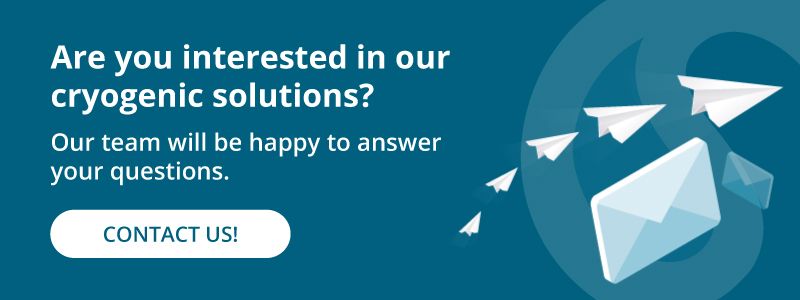The cryogenic market looks set to keep growing over the coming years at exponential speed. The growth in investments for LNG infrastructure, the increasing demand for industrial gases and the interest in sustainable and low-carbon energy sources, is driving cryogenic technology to be applied in both traditional and new industries. Keep reading and discover how to optimize industrial cryogenic engineering projects and see the latest trends in the cryogenic industry.
In order to improve processes and achieve more stable goods, clothing, dairy, chemical, electrical, optical, automobile, metallurgical, and a host of other industries now take full advantage of engineering projects harnessing cryogenic technology.
What are the main trends in industrial cryogenic engineering projects?
- For industries transitioning to Factory Automation technology, there are several factors: These involve improving the quality of manufacturing lines, allowing greater use of energy and output. Recruitment issues also contribute to the solution of suppliers.
- In production plants, immersive, digital and hybrid reality can be used in many ways. This covers product planning, construction of manufacturing lines, OEE upgrades, technological and infrastructure assistance, recruitment, team coordination, inventory control, etc.
- Digital twins have become an autonomous system that is becoming an immensely significant instrument of production. A Digital Twin is indeed an accurate simulated copy of a physical entity, system or product, modified in actual environments.
- Digitalization can be sometimes be referred to as “digital transition”. It means using emerging technology to adapt or turn the enterprise into a digital enterprise.
- Cobots nowadays are both healthier, more resilient and much more lightweight and economical. Cobots provide producers with ways to upgrade their manufacturing lines while maintaining safety and increased efficiency.
Discover our 3D Cryogenic Flat-Bottom Tank Design
What is the main advantage of using cryogenics in innovative engineering projects?
Cryogenics engineering is a technology that focuses on extremely low temperature processing results and repair. The analysis of product compositions at the cryogenic levels is also included.
The use of this research is supportive to classical technologies; allowing the use of cryogenic liquids and extremely advanced low-temperature freezers developed from their roots in the isolation of air and desalination of gases throughout decades.
Cryogenic technologies have now been developed in a broad range of applications including freezing food, medication, scientific research, liquefied petroleum oil, gas storage, transportation, electricity and security.
The key elements of cryogenic systems are heat exchangers. Cryogenic heat exchangers should really be configured to run at comparatively low temperature differences to ensure reasonable total energy efficiency in the device, which is mainly dictated by the renewable sources of the compressors.
Using more advanced techniques, it is possible to reach temperatures even closer to absolute zero, such as those applied in dilution refrigerators and adiabatic demagnetization. Such methods are mostly used in experiments as the impact of quantum theory in macroscopic organisms can be seen at relatively low temperatures. This calls for higher heat transfer fields; which therefore means appliances with high initial cost.
For these heating systems to be economically effective, high performance is required. 1% growth in the performance of a cryogenic heating system for an air separating device has been shown to minimize the compressor’s energy usage by 5%.
Cryogenic manufacturing is an on-time, reversible extraction of the product to improve its mechanical and physical properties at extremely low temperatures. A broad range of techniques like materials, composites, polyethylene, silicon carbide, ceramics and composite materials can be treated by cryogenic manufacturing.
Cryogenic polymer technologies aren’t confined to sectors of space science, electromagnetic technology and superconductors. They also turn up in many other specialized methods, such as cryo-surgery and clinical cryobiology.
Keep reading: Cellular Glass: Getting to the bottom of Cryogenic Tanks
How does cryogenic technology help minimize environmental impact?
While better options to existing vapor – compression refrigeration units supplied from auxiliary internal combustion engines because of their capacity for reduced environmental impact and fast cooling efficiency, cryogenic transport refrigeration systems of liquid carbon dioxide or liquid nitrogen are suggested. In addition to providing corrosion, efficiency and finishing (friction), cryogenic cooling is indeed a favorable and eco-friendly process that often converts into certain benefits.
This is not only good for the atmosphere, however; tests consistently show employees are exposed to health hazards due to oil vapor inhalation over years. Its use in manufacturing processes improves products’ capacity, decreases costs and makes for reduced environmental effects. This means that its low temperature can be applied to fibers, fabrics or metals.
Best Cryospain services for industrial cryogenic engineering projects
At Cryospain, we are leaders in the design, tailored manufacturing, commissioning, and maintenance of cryogenic equipment and engineering projects. We providehigh-tech cryogenic engineering facilities and equipment for engineering projects such as:
- Flat-BottomCryogenic Tanks
- Vacuum-Insulated Pipes for Cryogenic Systems
- Mechanical and thermal design, manufacture and commissioning of the transformation of ships to LNG.
- CO2 and N2O filling stations
- High pressure gas filling stations
- Satellite LNG regasification plants
- CNG, LNG and CNG stations
- Train transformation to LNG
- Cryogenic custom equipment
- Trolleys and bot filling ramps
We provide cryogenic equipment repair and maintenance services, distribute products from the most recognized brands in the sector and supply our own products for the transport and storage of liquefied gases.
We work closely with our clients to achieve the most efficient solutions that best suit their needs. As technology partners, our priority is to offer personal, quality service that meets the requirements and expectations of the companies we serve.
Interested in learning more?? Contact us today.











 Contacte-nos
Contacte-nos